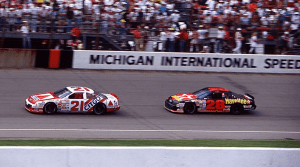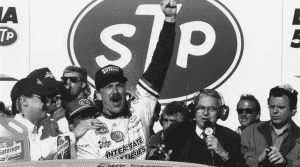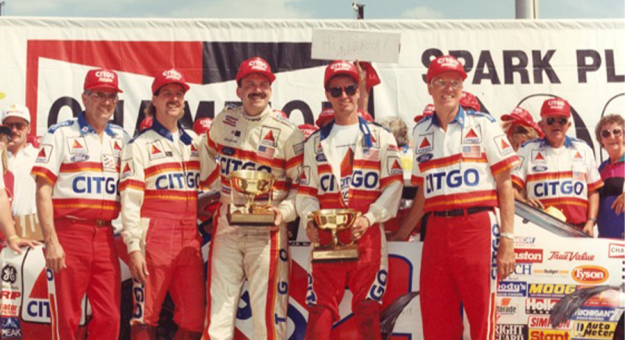Editor’s Note: This is the second of a four-part series on NASCAR Hall of Famer Dale Jarrett. Click here to read part one.
After his departure from Cale Yarborough Motorsports, Dale Jarrett began the 1990 season in the NASCAR Xfinity Series.
However, an opportunity opened when Neil Bonnett was injured in a crash at at Darlington (S.C.) Raceway. As a result, Jarrett was tabbed to replace Bonnett aboard the famed No. 21 Wood Brothers Racing machine.
Promising results in the final 24 races allowed Jarrett to keep the ride for the 1991 season.
From there, Jarrett’s career trajectory began to rise.
A string of three consecutive top-10 finishes during the summer months led to Jarrett’s first NASCAR Cup Series victory.
An intense battle with Davey Allison led to a photo finish at Michigan Int’l Speedway, with Jarrett edging Allison to secure the victory.
“That was just an incredible day,” Jarrett said. “I mean, first off to be driving for the Wood Brothers in that famed 21 car, that chance that came along and to be there. To know everything that was taking place there that it was Davey Allison who had the field covered that day with his Robert Yates horsepower and his driving ability.
“For us to put ourselves in a position by taking no tires, just getting fuel and getting ourselves out front, and then to have to battle with him to win your first Cup race like that. It’s like something that you want to write a book about.
“I couldn’t have asked for something better. That first win to be with the Wood Brothers who basically said this many times, a lot of people might not get that second chance at a career, but the Wood Brothers gave me that opportunity I feel like.”

It was an important victory for Jarrett after previous Cup Series opportunities didn’t pan out.
“I was out of the Cup side of it back running my own Busch team again and doing that full time when the opportunity came along. To do that with them, again, another storybook ending or beginning for me.”
At season’s end, Jarrett ranked 17th in points with eight top-10 finishes.
1992 arrived, with a new team emerging in the Cup Series — Joe Gibbs Racing.
Even though Jarrett felt settled with the Wood Brothers, three-time Super Bowl champion head coach Joe Gibbs coaxed Jarrett into becoming Joe Gibbs Racing’s first driver ahead of its inaugural season in 1992.
“I think the biggest thing was, if you ever get the opportunity to sit down and talk to Joe Gibbs and listen to him, he’s very convincing,” Jarrett said. “And yeah, I knew that, ‘Hey, this is a Super Bowl winning football coach that’s trying to get into racing.’
“I think a lot of people wondered why I would leave the Wood Brothers and at times, I questioned myself before I made that decision. But, Joe Gibbs was very convincing to me that he was going to do things the right way. I knew he had an alliance with Rick Hendrick. He took my request to hire my brother-in-law, Jimmy Makar away from Blue Max (Racing) and Rusty Wallace, and the Penske side of it.”
Makar, who retired from his Senior Vice President role at JGR in November, was one of the first employees at the Huntersville, N.C. operation.
“That was the big difference, because I thought Jimmy was that person that could do that for me,” Jarrett said. “With Coach Gibbs’ guidance, he literally changed my life in many ways. That opportunity was there, and I appreciated that.
“I felt like the introduction to him through Max Helton, who was the head of Motor Racing Outreach, that that all happened for a reason. There were life changing moments, with my time with Joe Gibbs. He is still one of my best friends in the world.”
It only took one season for the pairing of Jarrett and Gibbs to find success. The duo sent shockwaves through the garage area, after their inaugural win together in the 1993 Daytona 500.

The race for the win brought an intense final three laps against some of NASCAR’s finest in Dale Earnhardt and Jeff Gordon.
“That’s an incredible scenario there. The pass on Earnhardt was difficult, but the harder pass was getting by this rookie named Jeff Gordon, in his first Daytona 500,” Jarrett said. “He was keeping me from getting to the opportunity. I could see that Earnhardt’s car was very loose because he’d only changed two tires, where Jimmy Makar put four tires on my car.
“I knew that was going to be an advantage. But Gordon was making it very difficult. Finally I was able to get to the inside of him and then set my sights on Earnhardt. I knew once I got to his bumper, going into turn three, as we were coming to get the white flag that I could get him loose enough that he just couldn’t turn his car down.”
Sure enough, Jarrett made that move work to perfection. The driver of the No. 18 Chevrolet Lumina held the lead for the final lap to give JGR their first victory in NASCAR.
“It worked out perfectly. It was a scenario where my dad (Ned Jarrett) was calling the race for CBS,” Jarrett said. “It’s probably something that we both get talked to more about that than anything else that we accomplished in our career, was that day of him calling the race and me winning the Daytona 500 over Dale Earnhardt.”
Jarrett and Gibbs finished the 1993 season fourth in points. A victory at Charlotte (N.C.) one year later would cap off their relationship in the Cup Series.
“I appreciate the time that I had there and the opportunity to bring them their first win,” Jarrett said. “For that first win to be the Daytona 500. When I go to their shop, and you see all the banners hanging there, which are now at 200, I believe.
“To see the first two are mine, that I won the first two races there. Obviously they’ve gone on to bigger and better things from that. It’s just an incredible experience to get to spend time with him. You talk about having Cale Yarborough on one side to get to talk about the racing aspect of it.
“With Joe Gibbs you get whole life experience there. So, you put that together with the opportunity to drive good cars, and it became a very successful pairing for us.”
Jarrett’s time aboard the No. 18 Interstate Batteries machine would end at the conclusion of the 1994 season.
However, a championship-caliber opportunity was on the horizon.
Find out more in part three — tomorrow.
Follow @DHoffmanMedia22